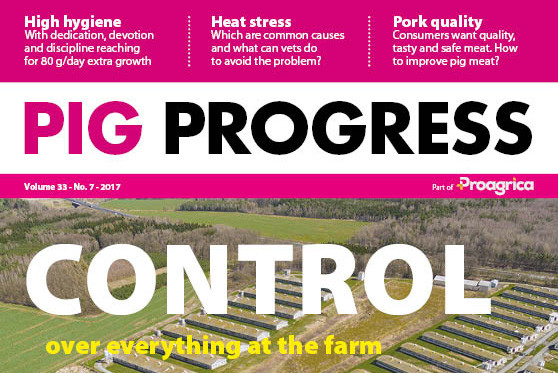Pig Progress 8: A new look & giving pathogens no chance

Check out the latest edition of Pig Progress with its striking new, fresh look and feel. In addition to this, the issue features a couple of interesting and insightful articles on how to prevent pathogens from standing a chance in doing harm at a pig farm.
The new look & feel of our magazines was first introduced for Proagrica’s latest title Future Farming and has now been rolled out in all our titles, which also includes Poultry World, All About Feed and Dairy Global. Content-wise the magazine is still the strong combination of topics you are used to.
Reducing antibiotics
Reducing antibiotics is a worldwide theme. In the ongoing wave of solutions being presented, arguably the most logical approach is that of MS Schippers: if pathogens can be kept out of the farm’s buildings in the first place, they don’t have to be fought at all.
They launched the HyCare concept – a zero-tolerance approach towards many pathogens and Pig Progress editor Vincent ter Beek took a look at a farm applying this strategy. The farmer himself is very satisfied. Page 24
Having high level control
The weakest link on farms are often the humans working there and that has been the key to an approach which is introduced by Carlos Piñeiro, of PigChamp Pro Europa. He introduces an automatic system, which can be used to check the movements of all farm staff – and in case they go against the farm’s biosecurity interests, an intervention can follow. Simple, but very effective. Page 10
Going down the genetics path
Yet another way to control and avoid the occurrence of diseases is to make sure that certain animals simply are not that much susceptible to illnesses. Researchers from the University of Guelph, ON, Canada, have been working for some while on identifying pigs with higher immune responses, and are using this information to breed pigs that are better prepared. Page 12

Interview with feed additives pioneer
When talking about antibiotics reduction, usually feed solutions are never far off. On the Canadian market, Jean Fontaine, founder and president of Jefo, has been working hard to convince the country’s livestock industry that there is a way forward using other methods than antibiotics alone. But, he said, “it’s been a long fight”. Our correspondent Treena Hein spoke to him – and about the road he took. Page 18
Feeding the sows, healthier piglets
Nutrition can also indirectly take care of healthier piglets. That becomes clear in an interesting contribution by Olga Dansen, of feed additives manufacturer Framelco. With the use of alpha-monoglycerides in sow diets, piglets can come out stronger. Page 30
Fumonisins
Fumonisins, mycotoxins created by Fusarium fungi, can be very detrimental for pig health. Nutritional solutions can help overcome this problem, writes Michele Muccio of Biomin. Especially now the company’s Mycotoxin Survey has shown that fumonisins are on the rise worldwide. Page 32

Nutrition and meat quality
A different effect of certain feed additives is, in the long term, the influence on meat quality. Ester Vinyeta and Kostas Syriopoulos of Austrian feed additive manufacturer Delacon figured out what the effects could be of the use of phytogenics. Page 28
Increasing piglet litterweight
Cargill Animal Nutrition usually looks at the bigger picture and does not zoom in on one strategy: how to make sure that all piglets achieve sufficient nutrient intake? They developed an entire programme for piglets before weaning, Dr Marc Decoux explains more. Page 34
Boar feed tests positive
The Belgian company Dumoulin introduced a special feed that can be fed to entire males in order to reduce the chances of having boar taint. The company did a series of trials and everything seems very positive with this solution. Page 39

Heat stress series – a veterinary view
In a multi-episode series Pig Progress will zoom in on the theme of heat stress. This issue we’ll take the veterinary angle: what causes stress and what can a vet do to avoid problems? Page 36
Research: Tail docking
For researchers, tail biting and tail docking are subjects that keep puzzling them. Why do pigs start tail biting and what can we learn to avoid the problem. The research consortium FareWellDock took a deep dive into the problem, this month they explain the effect of using straw. Page 8
Join us to Nepal
In our series ‘Country Focus’, Pig Progress travels to Nepal. As correspondent Kam Raj Pant describes, the country doesn’t have a long pig production or consumption tradition, but for several reasons this is rapidly changing. Page 14

Columns on condensation and pain relief
Regular management columnist John Gadd has a couple of strong recommendations on condensation in pig farms. Knowing how it develops get pig producers half way in finding a solution. Page 21
Animal welfare columnist Dr Monique Pairis-Garcia observed the introduction of a pain relief medicine on the US market. A breakthrough, she describes, and she explains what the future could hold in this respect for pigs. Page 42
To read all the articles in this issue, go to the magazine overview page and sign up with your current website login.











